Ailish Donachie, History Student, University of Stirling
We are pleased to host this blog by history student Ailish Donachie, who recently returned from a trip to Budapest organised by the Holocaust Educational Trust. In it, she discusses the important place of food in the life stories of Hungarian Holocaust survivors
Food is something that unites us all, no matter who you are, where you are from, or your background. Everyone has a personal connection to food often through traditions that can last several generations or by coming up with new traditions that have personal meaning. Our connections to food can therefore also be a good lens through which to understand the past and draw meaningful connections to the present.
The Holocaust intended to strip Jewish people of their humanity by persecuting Jews for their identity. However, even under these circumstances some Jewish people found a way to hold onto their culture, their identity, and their humanity through sharing traditional recipes. It was a simple yet effective way of resisting persecution. Many of those who survived the Holocaust have shared their recipes with their families, who then have shared these with the world, allowing their culture, heritage and memory to live on through the love and passion that lies in food.
As an example, we can trace this resistance to Nazi persecution and passing on their heritage through the experience of Hungarian Jews during the Holocaust. Although collaboration existed on different levels in several occupied countries, the Hungarian government directly worked with Nazi Germany and often worked hand in hard in the persecution of its Jewish population. The Hungarian government played a significant role as a perpetrator of the Holocaust, although it only deported its own Jewish population after occupation by the Nazis. In an interview Holocaust survivor Steven Fenves discussed his experience of the Holocaust as a child in Hungary:
The entire – even after German occupation, up to and including loading into – into the railroad cars, I don’t remember seeing a German…Yes it was all done by Hungarian gendarmerie.
Holocaust survivor Steven Fenves
This highlights how involved the Hungarian authorities were in the Holocaust and the persecution of their own Jewish citizens. It is important to remember that collaboration in the murder and oppression of Hungarian Jews was immense. Approximately 440,000 Jewish Hungarians were transported out of Hungary and almost all went to Auschwitz or Auschwitz-Birkenau. Alongside the deportations there was a very large number of Jews who were killed before being transported out of Hungary, from forced labour and mass shootings, as well as the poor conditions and treatment faced whilst many were forced into ghettos across Hungary. All in all, Yad Vashem records 568,000 Jewish Hungarians to have died during the Holocaust.
Yet, beyond the numbers and statistics of those 440,000 deported Hungarian Jews there are individual lives – individual people, with families, friends, and each with their own unique experience of the Holocaust. 440,000 traditions and family recipes lost to Nazi prosecution. For this reason, when remembering the Holocaust and its victims it is important that we also remember the individual people and their individual experience. One way to do so is by looking at personal experiences through the testimony and personal items of survivors. Recipes are among the most personal items and can often tell the stories of entire family traditions.
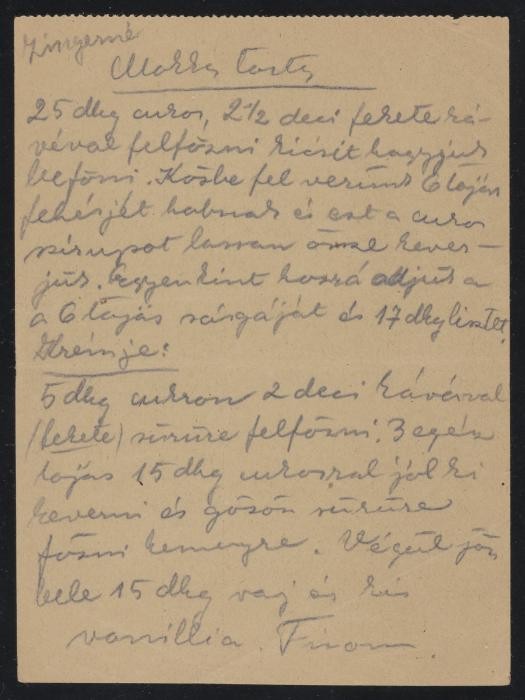
‘Mrs Zinger’s recipe for Mocha Cake’, US Holocaust Memorial Museum Collection (https://encyclopedia.ushmm.org/content/en/document/mrs-zingers-recipe-for-mocha-cake)
Holocaust survivor Ilona Kellner (known as Ica) collected approximately 600 recipes from fellow inmates during her time working at a Nazi labour camp after being deported there from Auschwitz. Ica collected these recipes on pieces of paper she smuggled out of rubbish bins alongside a small pencil she found and managed to take with her into the bunks. Ica hid the recipes from the Nazi guards by carrying them in a small pouch in her jacket and even carried them with her on a death march, a few days before she was liberated. Ica’s daughter Eva Moreimi wrote in the memoir Hidden Memories:
In the evenings they huddled together in the barracks and talked about food…Talking about their food and remembering beloved family dishes gave them hope and a reason to survive.
Eva Moreimi, daughter of Holocaust survivor Ilona Kellner
After Ica survived the Holocaust, she kept these recipes she gathered close to her heart and would often look through them to use as inspiration for what to make.
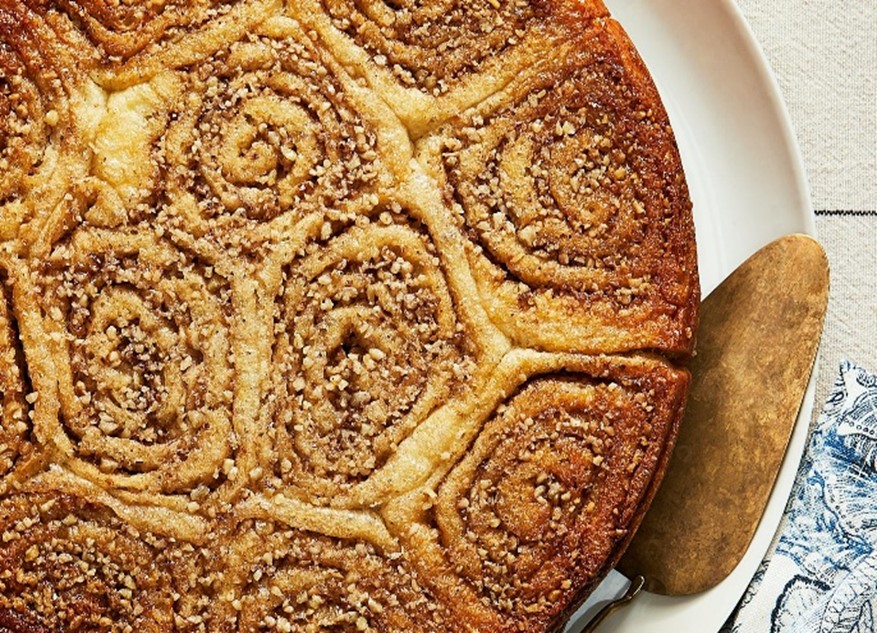
Hungarian Wasp Nest (Photo by Armando Rafael courtesy of Jewish Food Society https://www.jewishfoodsociety.org/recipes/hungarian-wasp-nest)
One of the recipes Ica collected is the Hungarian Wasp Nest, also known as Darázsfésze. These buns are very similar to cinnamon buns, but are filled with walnuts. The yeasted dough is rolled up, sliced and baked. Eva, Ica’s daughter, has stated the nuts can be replaced with vanilla. Eva recalls her mother making these buns every year for Shavuot, which is a tradition she has continued herself. This highlights the centrality of food to keep traditions, memories, and stories alive. By baking the Hungarian wasp nest and sharing the recipe the tradition of many Jewish people has been carried on through food. It’s a story of survival and defiance.
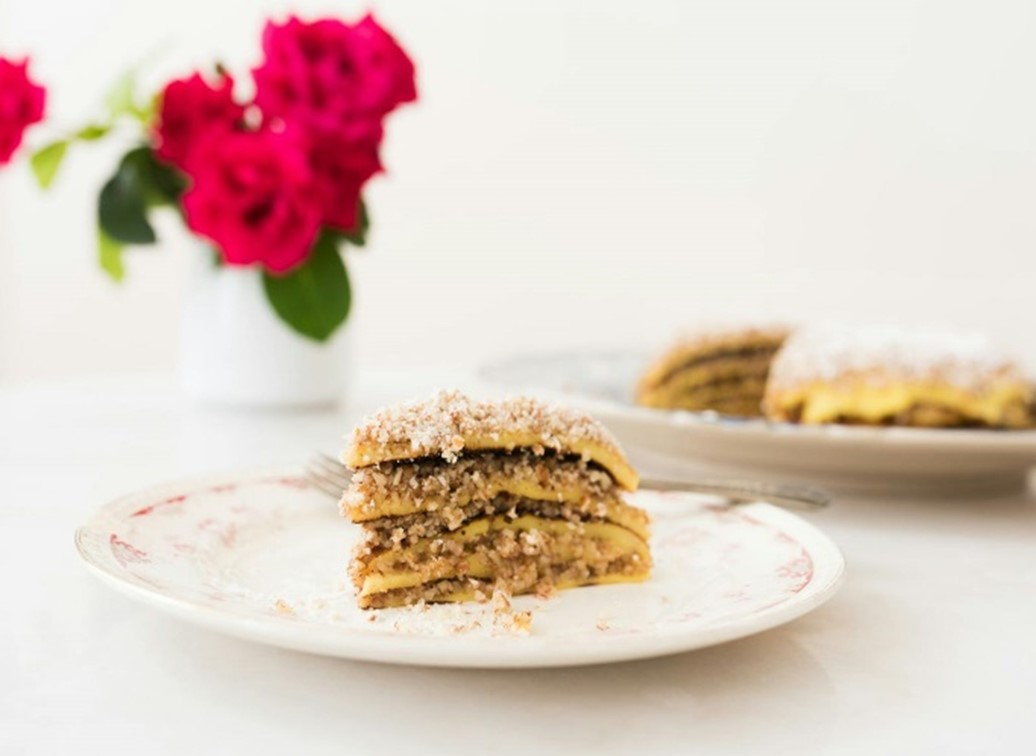
Csusztatott Palacsinta (Hungarian Layer Cake With Pecans and Vanilla) (Photo by Dave Katz courtesy of Jewish Food Society https://www.jewishfoodsociety.org/recipes/csusztatott-palacsinta-hungarian-layer-cake-with-pecans)
Another recipe that was shared is the Csusztatott Palacsinta (Hungarian layer cake with pecans and vanilla). The recipe was shared by Hein Zeidner Kapsi, the wife of Martha Roth’s grandson who shared the family recipe after becoming very interested in the recipes Martha had. Originally from Slovakia, Martha managed to survive the Holocaust after escaping to Hungary before being imprisoned. Martha moved to Israel after the war and became a skilled baker and cook. Her family still use their recipes and share them with one another. Martha was very secretive about her recipes which made it a difficult task for Hein to perfect the recipe after remaking the cake multiple times. Alongside her recipes, it was very hard to find more information on Martha and her life apart from what has been shared by her family. However, the larger impact her food had on her family is clear. The effort to recreate the perfect recipe highlights the connection between food, memories of Martha and the traditions her family kept alive. It reinforces how important food can be in carrying on legacies as well as the memory of people’s lives and the traditions people took part in. Through the shared food the life many had before the Holocaust could be continued through future generations.
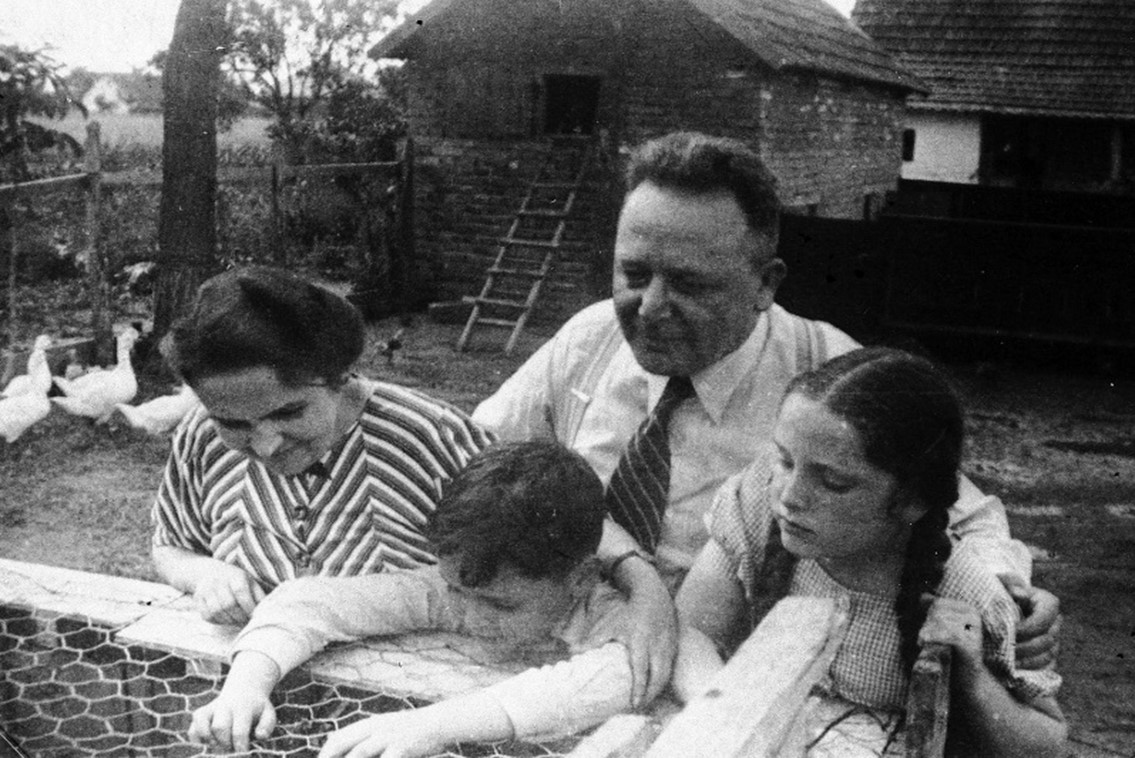
The Fenyves family at their vineyard in what was then Subotica, Yugoslavia, c. 1935-38, US Holocaust Memorial Museum Collection, courtesy of Steven J. Fenves (https://collections.ushmm.org/search/catalog/pa1151877)
Klári Fenyves’s family cookbook also managed to survive the Holocaust and keep the memory of her family members alive. She created a cookbook full of family recipes and family favourite meals but had to leave the book behind when they were forced to leave their family home. The family’s cook managed to save the cookbook alongside some of Klári’s artwork which was returned to the family after the war.
Klári’s son, Steven Fenyves (later known as Fenves) stated in an interview about his experience of the Holocaust that:
One of the nastiest memories I have is getting – going on that journey, and people were lined up, up the stairs, up to the door of the apartment, waiting to ransack whatever we left behind, cursing at us, yelling at us, spitting at us as we left…Like vultures, right. Except among them was our cook. She went in, she grabbed the cookbook, and she grabbed this folder of – this binder, and shoved into it all the artwork that she could shove into it.
Holocaust survivor Steven Fenves
In March of 1944, Klári alongside her two children, Steven and Estera, were forced into a ghetto before being taken to a transit camp and eventually to Auschwitz. Klári’s husband Lajos was deported to Auschwitz straight away. Steven, Estera and Lajos survived, but Klári was murdered in Auschwitz-Birkenau. Steven and his sister were dedicated to keeping their mother’s legacy and their love for their family food alive and donated Klári’s carefully curated family recipe book to the US Holocaust Museum. Not only this but Steven often spoke of his life and the recipes within his mother’s cookbook. In a live stream in 2020 alongside chef Alon Shaya, he told Steven’s story and indulged in creating a walnut cream cake which Steven had picked out as one of his favourite childhood recipes.
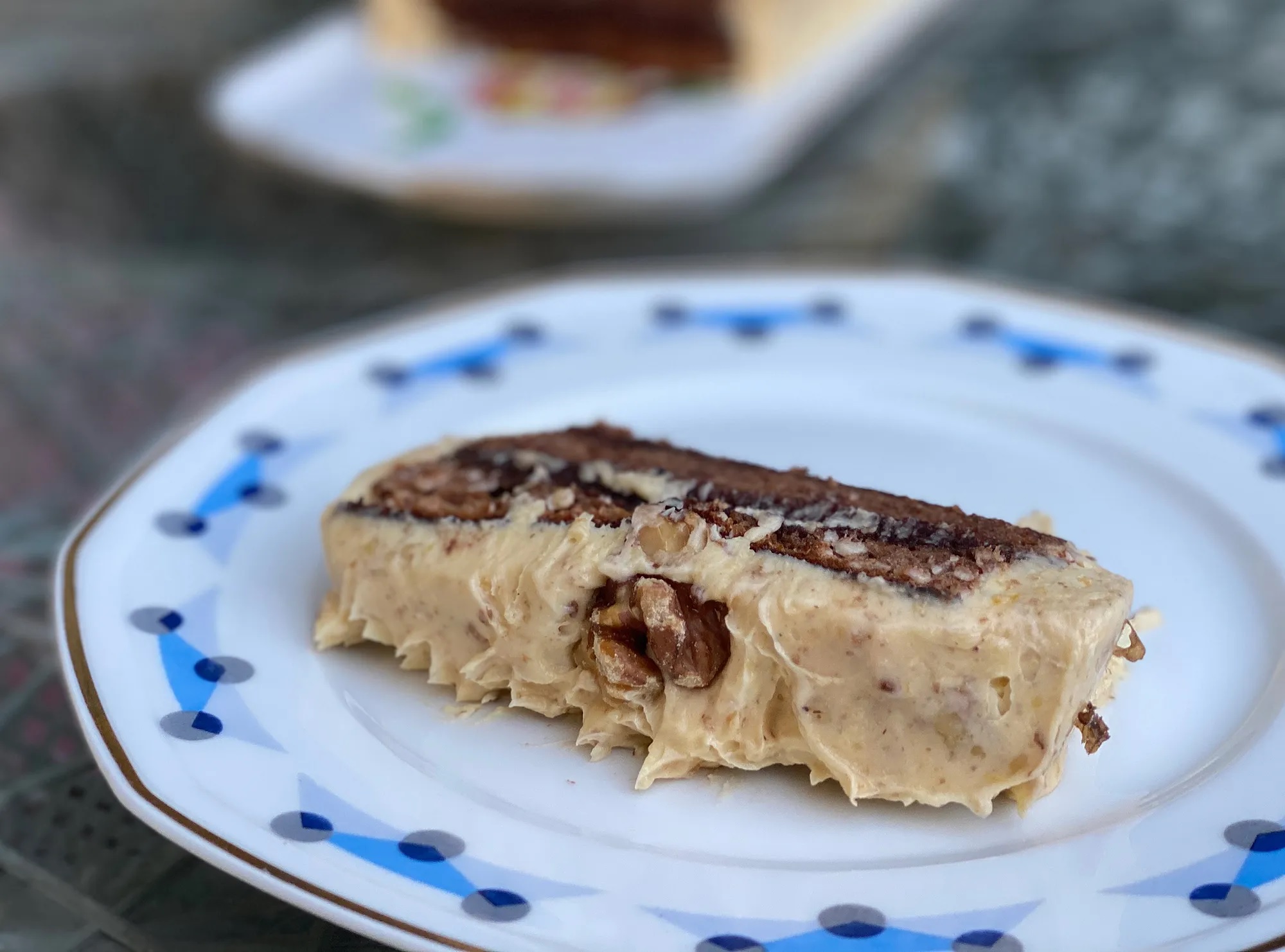
Walnut cream cake made from the Fenyves family recipe (Image by Emily Shaya, from Medium https://medium.com/memory-action/when-a-family-was-deported-their-cook-saved-treasured-recipes-34709abba724)
Throughout all the persecution Jewish people have faced, they have persevered and have never given up. Their culture, history, traditions and religion has survived against all odds as the resilience of the Jewish community and Holocaust survivors shine through. It can be seen clearly through their beloved recipes. By sharing recipes with families and the world Holocaust survivors have found a way to not let their experience be dominated by statistics. These can at times appear like the bigger focus in the history of the Holocaust, obscuring the individuality of each victim’s experience. The stories, the family histories and connections that come with collecting, sharing, cooking and baking Jewish recipes that survived their attempted destruction allows some humanity to be let back into that history. Food is a very personal thing for people and communities, it allows faces to be given back to the numbers that often leave the individuals and their unique experiences forgotten.
Sources:
‘The Woman Who Hid 600 Recipes From SS Officers’, Jewish Food Society (https://www.jewishfoodsociety.org/stories/the-woman-who-hid-600-recipes-from-ss-officers)
US Holocaust Memorial Museum, ‘When a Family Was Deported, Their Cook Saved Treasured Recipes: Make the Walnut Cream Cake’, Medium (https://medium.com/memory-action/when-a-family-was-deported-their-cook-saved-treasured-recipes-34709abba724)
US Holocaust Memorial Museum, ‘Steven Fenves Describes His Family’s Persecution during the Holocaust in Yugoslavia’ (youtube.com)
US Holocaust Memorial Museum, Interview with Steven Fenves, 25 March 2005 (https://collections.ushmm.org/oh_findingaids/RG-50.030.0494_trs_en.pdf)
Incredibly important piece of work – focusing on individuals as people rather than statistics. The link with food and traditions is a very interesting and effective way to highlight the strength of the Jewish communities that fought ethnic cleansing during the holocaust. A truly great body of work.